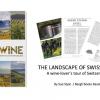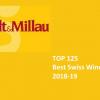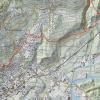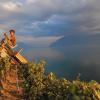Swiss Red Wines Report 2017 by Stephan Rheinhardt, The Wine Advocate
By Stephan Rheinhardt. To access the detailed notes and ratings you must subscribe to The Wine Advocate www.robertparker.com
Swiss people seem to be proud, saying: “Swiss wines are the best kept secret of Switzerland.” In fact, it’s not the Swiss mentality to shout out loud how great Swiss wines can be and that they should be appreciated everywhere on planet wine. I am sure they would be adored if only one knew them. However, Swiss wine producers don’t export (except for just a handful) for a few reasons.
First, there is simply not enough quantity. Swiss wines are produced in small volumes and serve a niche market. Second, due to high labor costs, the wine prices are pretty high, so there is virtually no chance for profit margins with Swiss wines. Third, the Swiss franc is as proud and adamant as the Matterhorn. And last but not least, Swiss people drink almost all of what’s being produced in Helvetia themselves. Less than 1.5% of the annual production is exported, and since the quantities were low three years in a row (2013 to 2015), this figure is declining further.
The wine qualities, however, are increasing over the years. As I have already said in my last report, this is not just a question of a younger generation or new ventures. There is a great dynamic in the Swiss wine scene, and it is even higher where the old and the young generations work together. With the international experiences of the younger generation, the wine style is slowly changing in Switzerland. Although most of the wines are still smooth and charming crowd-pleasers, with discreet acidity and tannin levels but baskets full of ripe fruits, more and more authentic and terroir-driven wines are emerging; but you have to taste a lot to find them. Since Swiss producers sell almost the whole production in Switzerland, there is no reason to change a commercially successful style that is also praised in the Swiss press.
However, I don’t find these round and often somewhat sweetish wines really exciting or thrilling. Downright grotesque are (mainly red) wines that seem to come from nowhere and everywhere. These “fake wines” try to imitate and challenge international icon wines, such as Bordeaux Grands Crus Classés, Sassicaia, Tignanello, Ornellaia or Opus One, with a mix of international and indigenous grape varieties, modern enology and pretty loud marketing. Eclectus is such a wine: highly expensive, produced to be the one and only icon wine of Switzerland but ended up as a wine without soul and not even well made.
Others, the very contrast to the fake wines, are still made like in the 1950s and 1960s, which is lovely and interesting but a curiosity in our modern times. If you prefer uncompromising tradition to greatness and concentration as well as to finesse and elegance, well, there are still many pale red wines being produced in Switzerland that are lean and floral rather than fruity and structured. The very best Swiss wines, however, are unique and distinctive, and they can compete with the finest red wines from Burgundy, Alsace and Germany as well as from the Northern Rhône or the Alpine wines from Northern Italy. Even the Jura is close, and not just geographically—it’s a part of northern Switzerland and its own AOC as well.
There is just one serious problem: How can you get all these beauties onto your palate?
Since Swiss wines don’t travel the world, you have to travel Switzerland. To be honest, that’s not a bad idea at all since there is much more to discover than just wine. So, take the plane to Zurich or to Geneva, rent a cabriolet (Switzerland is a very sunny country even though some areas like the Ticino have a lot of rainfall too), and check out one of the most beautiful and multifaceted wine regions of the world. You will find picturesque landscapes—snow-covered mountains and cyan-colored rivers and lakes—as well as continental, alpine and Mediterranean climate zones; ski, hiking and biking paradises; golf resorts; the finest restaurants, wine shops and bars; world-class cheeses and chocolates; history and art; and last but not least, four languages and cultures…. Or, how Tom Mullen recently put it in Forbes: “The secret attraction of Swiss wine is, well, Switzerland.”
To give you just a short overview: There are more appellations than cantons (almost 90!) in Switzerland, and there are about 240 different grape varieties cultivated on 14,780 hectares of vineyards. The vineyards in Switzerland are spread over three main parts, listed below.
- Eastern Switzerland (German-Swiss: 2,640 hectares), with Zurich (608 hectares), Schaffhausen (483 hectares) and Grisons (449 hectares) as the most important AOCs
- Western Switzerland (Suisse Romande: 11,020 hectares), including the three biggest cantons of Valais (4,875 hectares), Vaud (3,774 hectares) and Geneva (1,409 hectares)
- Southern Switzerland (Svizzera Italiana: 1,120 hectares), with Ticino holding 1,096 hectares
Fifty-seven percent of the vineyards are planted with red and 43% with white varieties. Pinot Noir is the most important red variety at 4,140 hectares and is predominantly planted in German-Swiss but also in the Valais. Then comes Gamay with 1,307 hectares planted and Merlot with 1,140 hectares. Grison, Zurich, and Three Lakes (especially Neuchâtel) are top destinations for Pinot Noir whereas Gamay performs very well in Geneva, and Merlot is the predominant grape of the great Rosso di Ticino. In the Valais, however, you shouldn't miss tasting Syrah or rare local varieties such as Cornalin, Humagne Rouge or the white Petite Arvine that gives gorgeous dry white wines and world-class noble sweet wines. Also, Heida (Savagnin) is a spectacular wine that grows in the Visperterminen in altitudes up to 1,100 meters above sea level. However, among the white varieties, Chasselas has the lead at 3,789 hectares. Especially in the Vaud but also in the Valais where it is called Fendant, the wine is not really spectacular in its discreet fruit aromas, but it has a serious and persistent character that can age for two or more decades, which is absolutely intriguing. Müller-Thurgau (466 hectares) and Chardonnay (369 hectares) are also important. So, if you want to keep Switzerland short and simple, you can say that Pinot Noir, Gamay, Merlot and Chasselas are the most important grape varieties—adding up to two-thirds of the total vineyard area—and that they are cultivated in three wine regions with three languages: German, French and Italian. But in fact, Switzerland’s true fascination is beyond this short formula.
Switzerland produces 108 million liters of wine in a good year like 2016, and 85 million liters in a year like 2015. That’s by far not enough to cover the requirements of the domestic market, where Swiss wines have a market share of 35% (imported wines come mainly from France, Italy, Spain and Portugal). That’s why less than 1.5% of the annual production is exported and why this won’t change. There is simply not enough quantity; this is also because Switzerland is a compartmentalized, structured wine region where talking about hectares is often a bit of window-dressing. It’s more realistic to talk about 20 different parcels or plots rather than one hectare of vines. Or, in the case of Jean-René Germanier in the extremely compartmentalized Valais: It’s better to speak about his 270 plots rather than about 40 hectares to which the parcels sum up!
Fromm’s gorgeous Spielmann Pinot Noir from the Grisons AOC (Eastern Switzerland) is from a tiny plot of 0.26 hectares that delivers grapes for three barriques in an excellent year but just two in a bad year. The four vintages from 2013 to 2016 were small years in terms of quantity in German-Swiss, but the qualities are mind-blowing. Swiss Pinot fans know it, so guess what happens to the few hundred bottles being produced every year?
If fine Swiss wines would fetch the prices of the finest Swiss watches, the overseas markets as well as Asia and Russia would probably have better chances to get a few bottles. However, even though Switzerland is an enormously wealthy state with high labor costs and high living standards, the wines are often stunningly cheap, especially with regard to their origins—often steep terraces that can only be cultivated by hand. A brand like Gantenbein is well known in Switzerland and abroad, even in the US. Martha and Daniel Gantenbein sell their excellent Pinot Noir and Chardonnay for a pretty proud price; they have to, because the couple farms just six hectares of vines and loves to drink the finest wines from Burgundy….
The Domaine de la Maison Carrée in Auvernier (Neuchâtel) produces outstanding Pinot Noir as well, even following biodynamic principles. The Perrochet family loves to drink fine Burgundies, too, but to them it’s easier to produce the finest Pinot Noir from Jurassic limestone themselves than to buy similar quality levels in Burgundy. The reason for this: The Perrochets sell their world class Pinots, from a total five hectares, for roughly a quarter of what Gantenbein is asking. The Swiss Pinot fans know about the quality, and some of them asked me not to mention the Domaine in my report since it is already difficult to order cases today. Due to small quantities and high demands, Jean-Denis Perrochet has to allocate his wines. From a difficult vintage such as 2014, you have to thank God if you are able to get at least a few bottles. At least the Domaine is in negotiations with a U.S. importer currently.
Histoire de l’Enfer is a relatively new producer in the Valais. Founded by three wine aficionados in 2008, this domaine produces outstanding Swiss wines on a high international level and with no fear of showing a lot of freshness and character. The Pinot Noirs are partly made with 100% of the stems, and the Syrah is spicy and vibrant like a top wine from the Northern Rhône, whereas the Petite Arvine Reserve is made almost like a Burgundy. The wines belong to the very best of the region and sell for prices between 30 and 60 Swiss francs, which is a good level but still not really expensive compared to their French counterparts.
Swiss wine, not just from the most prestigious wine regions, should be expensive because the labor costs are as high as the terraces of the Ticino or in the Valais (climbing from 500 up to 1,100 meters above sea level). At the moment, there is no chance for good profit margins for a wine that is completely unknown outside the homelands. Okay, there are a few exceptions, but again, we are talking about less than 1.4% of the total production.
Last but not least, the Swiss franc (CHF) is a strong currency (and one of the reasons for the fact that tourists in Switzerland do not principally come from France, Germany or Italy anymore but from Russia, Asia and India…).
This little report is composed of wines I tasted over the past six months, but the main part comes from producers who presented their wines at the fabulous Swiss Wine Tasting in Zurich at the end of August 2017 in the spectacular Schiffbau. I asked each of the roughly 130 producers to provide me with a single red wine to taste. They were free to decide which one to send. I got roughly 100 wines, many of them from the 2015 vintage, but there were also 2014s and a few from 2016 or older vintages. Since so many 2015s were not yet bottled or ready to present, I will deliver a second, smaller report later this year, so stay tuned.
About the two recent vintages
It is too early to evaluate 2016 based on just a few wines, but 2016 seems to be a classic vintage: clear, fresh and fruit-intense, with good vibrancy and rather moderate alcohol levels. Spring and early summer were cool and wet, with frost in late April and downy mildew in June due to the heavy rainfalls. July was finally warm and sunny but also attracted the suzukii fly again. The sunny and dry autumn brought excellent conditions for the harvest, and suzukii didn't cause any bigger problems in the end (like in 2014 for example). Yields were very good—up 25% compared to 2015—in the French and Italian part of the country, whereas in German-Switzerland (especially in the bigger cantons such as Zurich, Schaffhausen, Aargau and Grisons) the crop was even lower than in 2015—down by 6.1%.
The 2015 vintage was exceptional in terms of quality but one of the smallest in terms of quantity. This is due to an extremely hot and predominantly dry summer. Since there were no diseases or rot, the quality of the grapes was excellent; they were perfectly ripe and concentrated, with significantly higher must weights than usual.
There are many exceptional 2015s to discover, especially red wines on which I had a focus in this tasting. Pinot Noir, Merlot, Syrah and Cornalin are the wines you should focus on, but also don’t hesitate to taste Gamays and Chasselas, which are wines that go very well with fondue and raclette.
To access Stephan Rheinhardt detailed notes and ratings you must subscribe to The Wine Advocate www.robertparker.com





